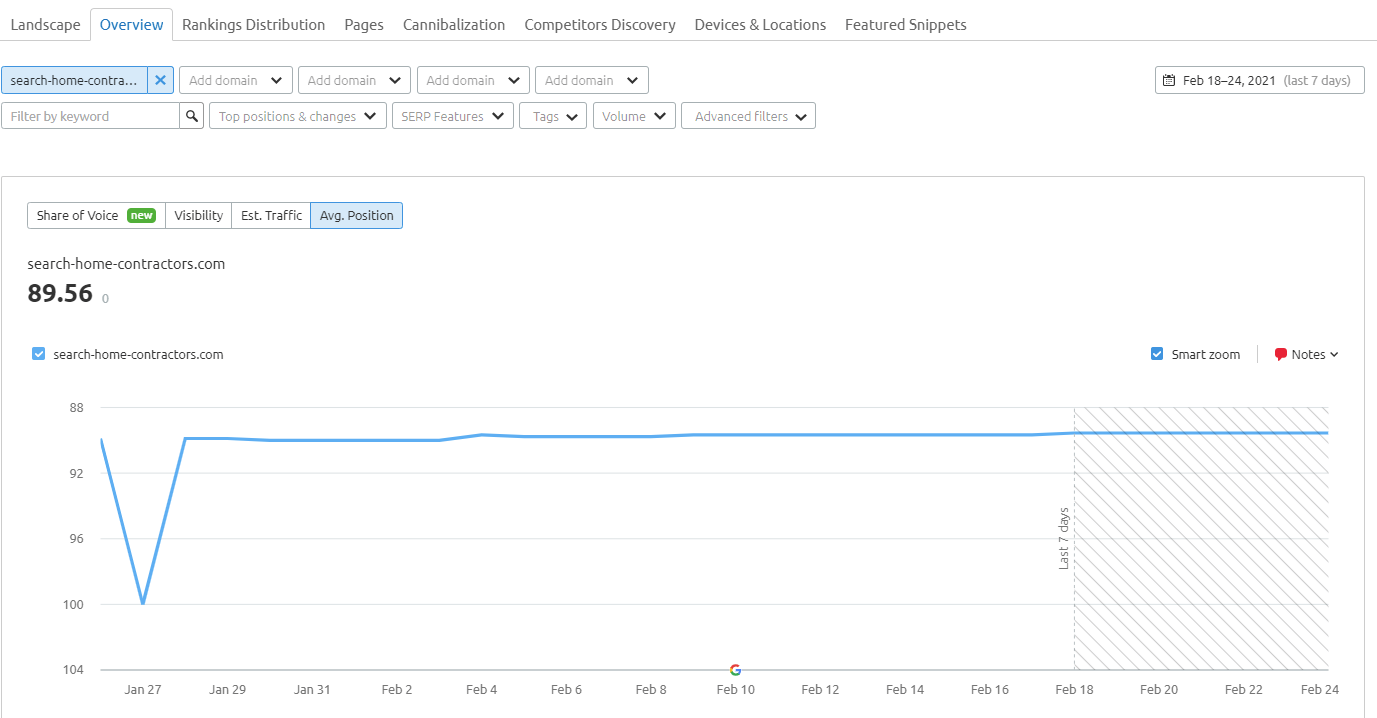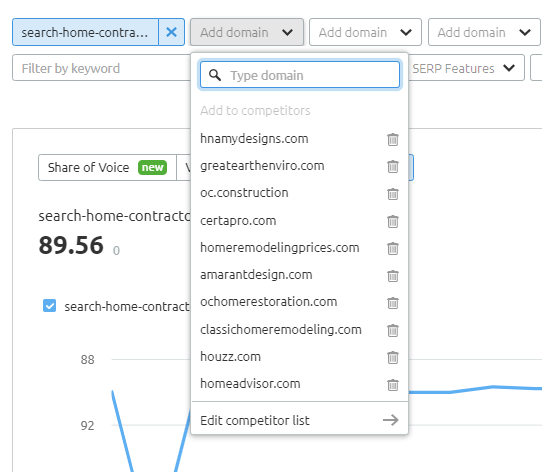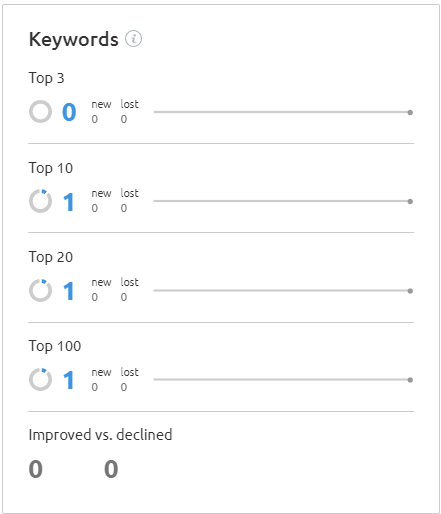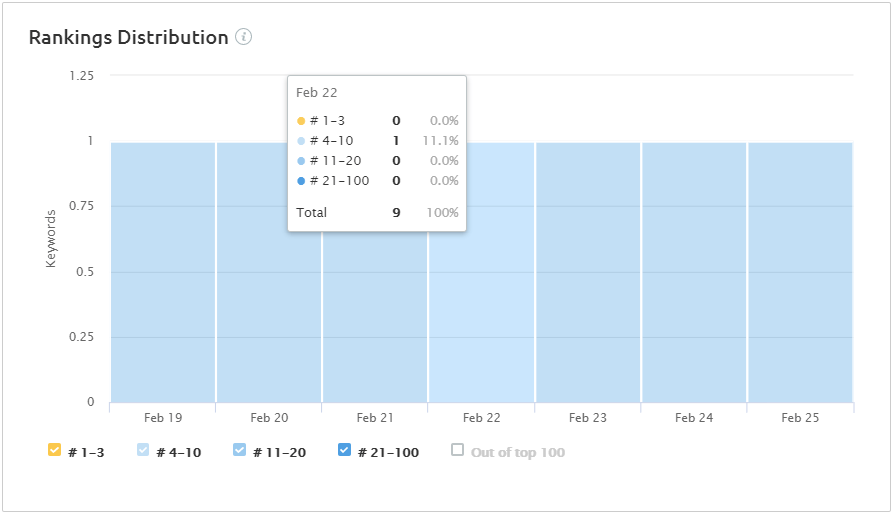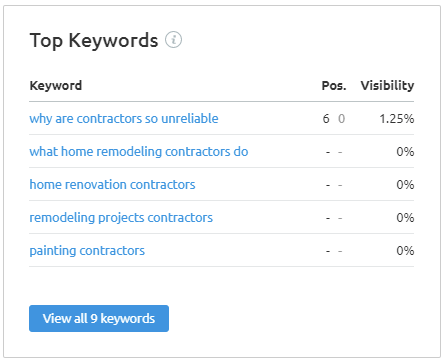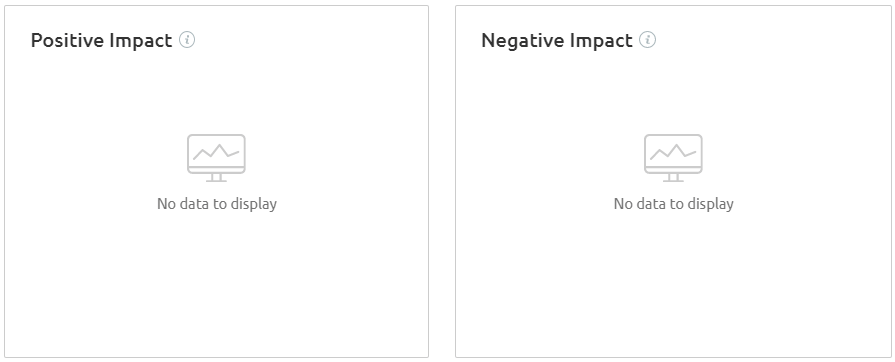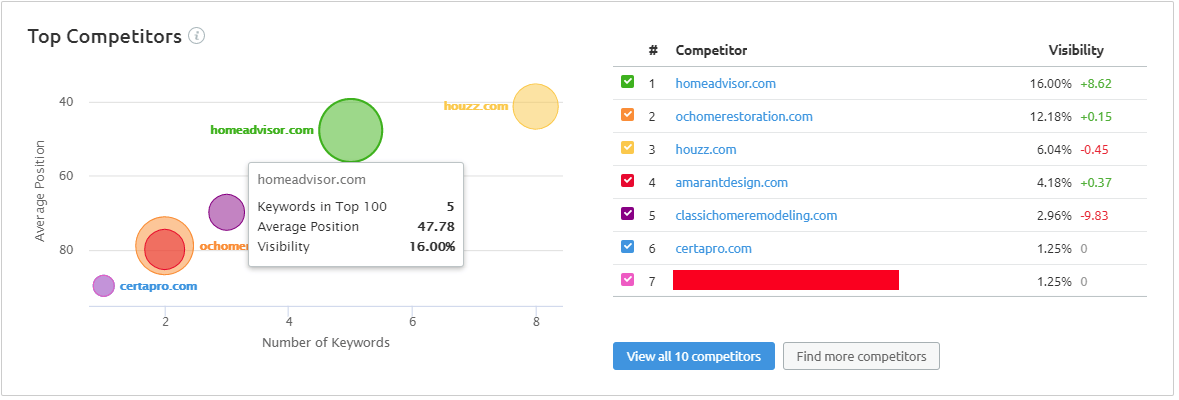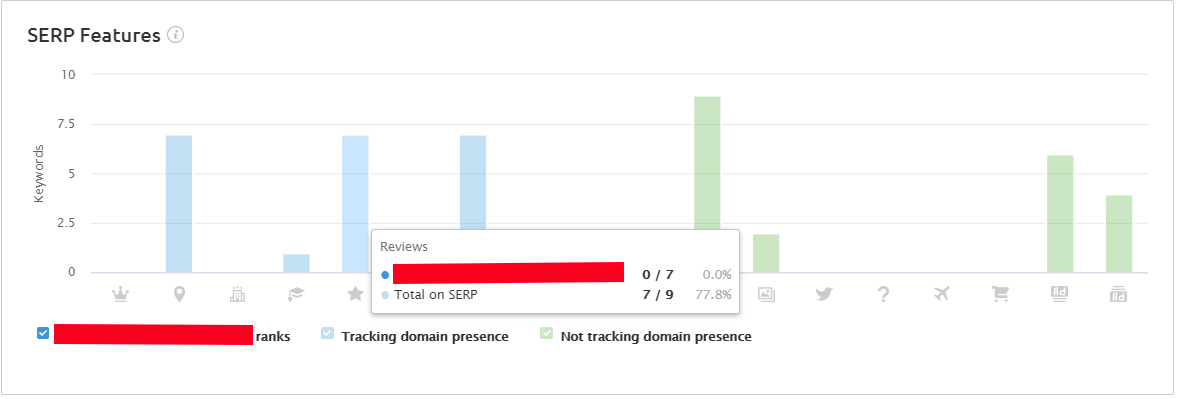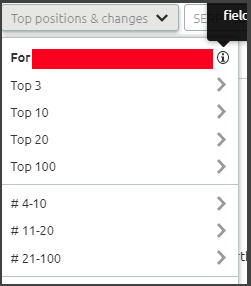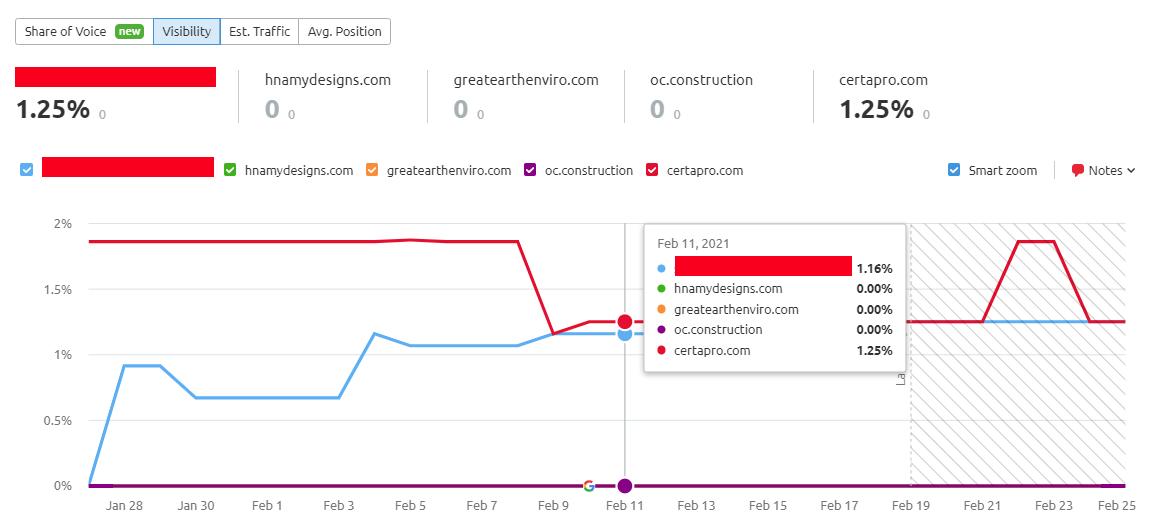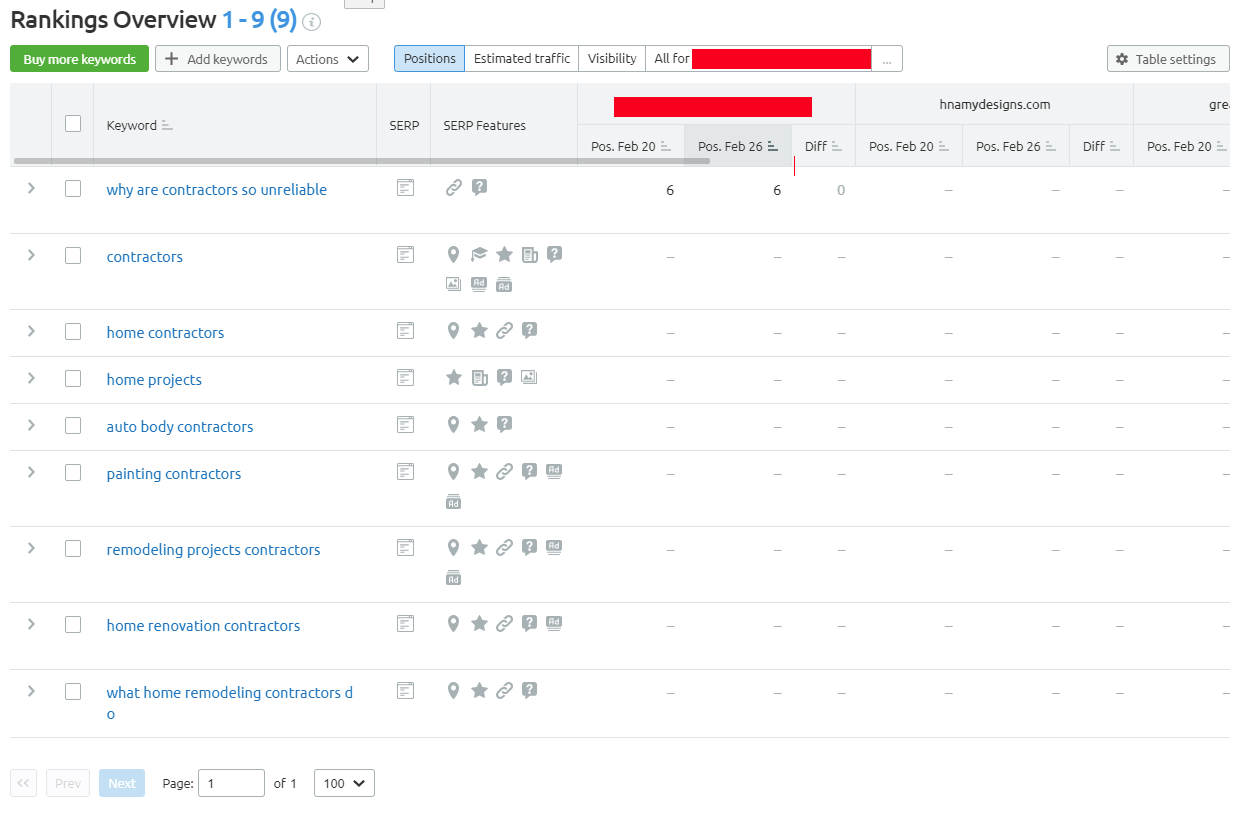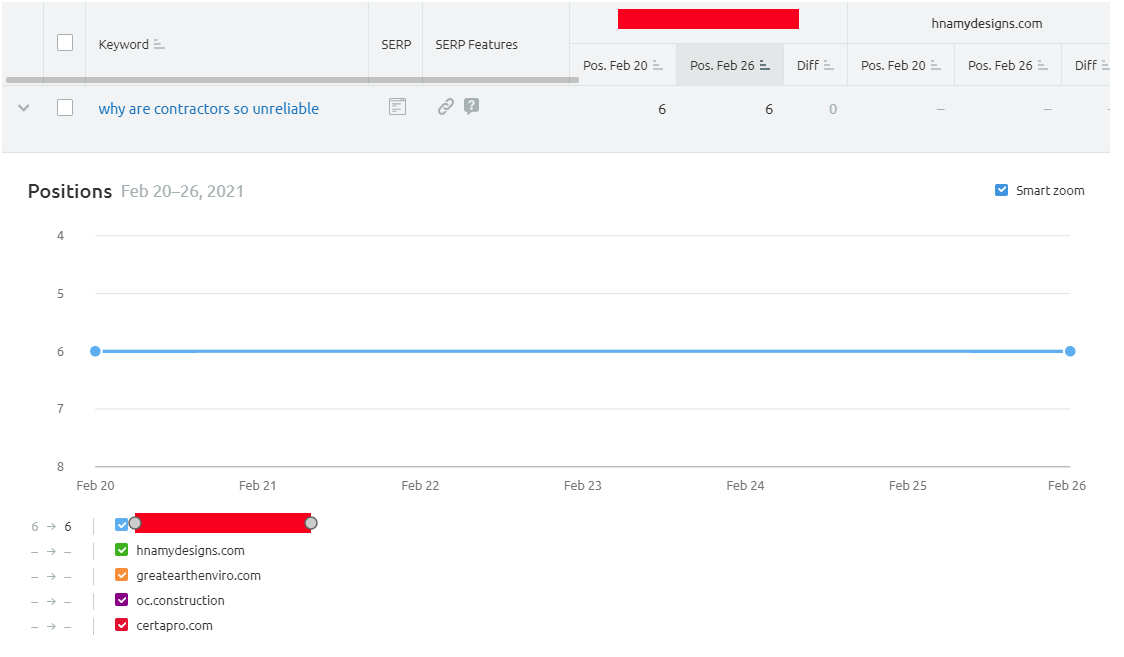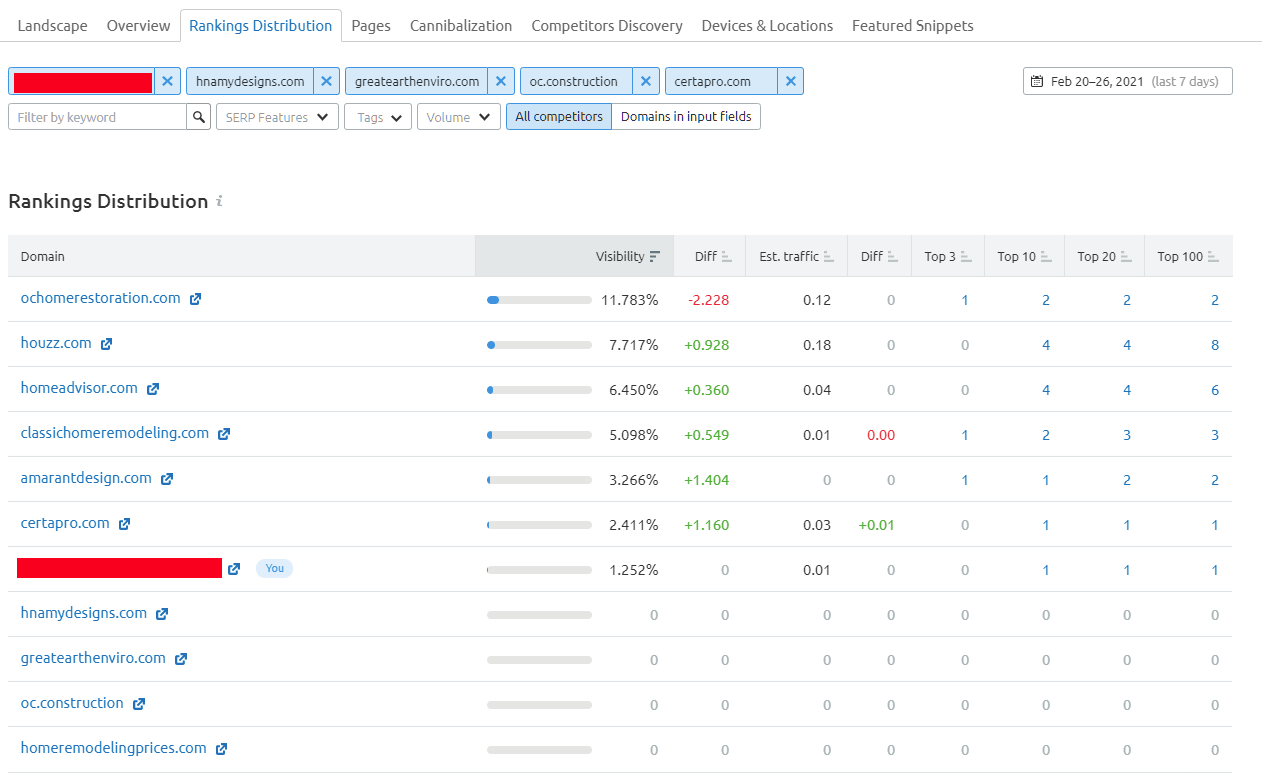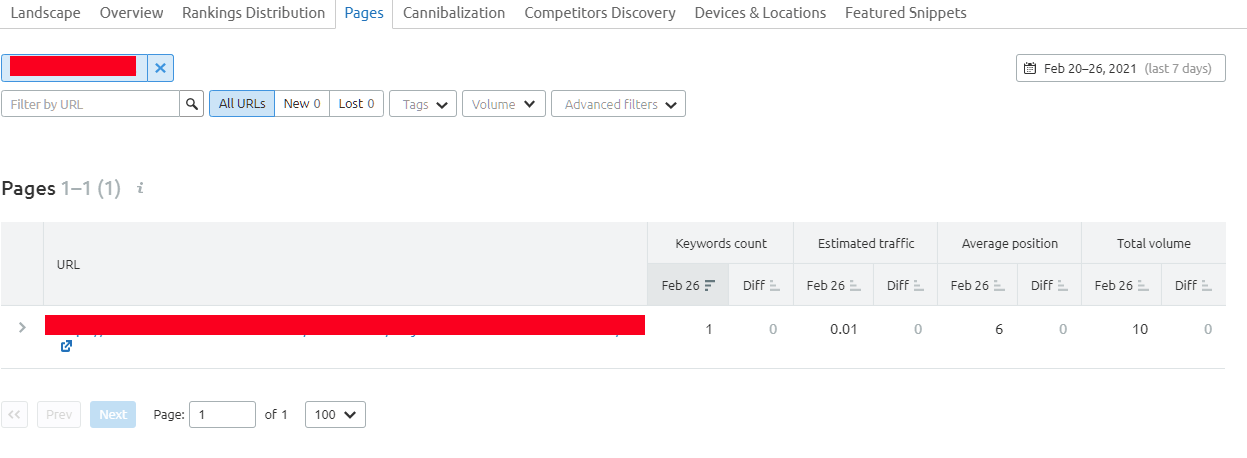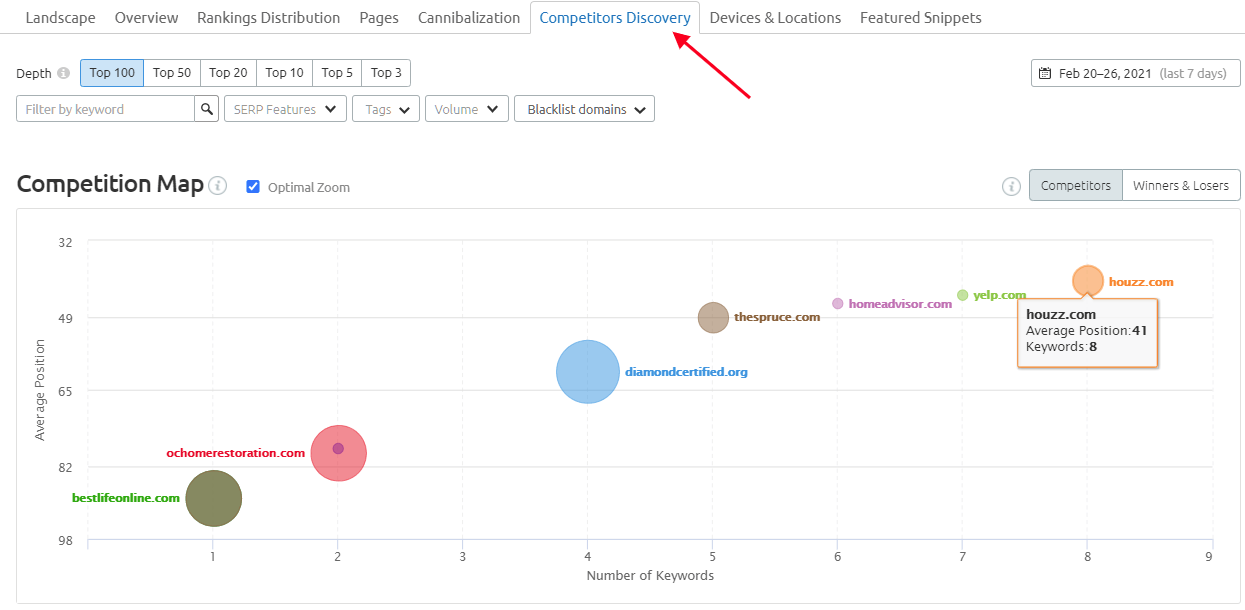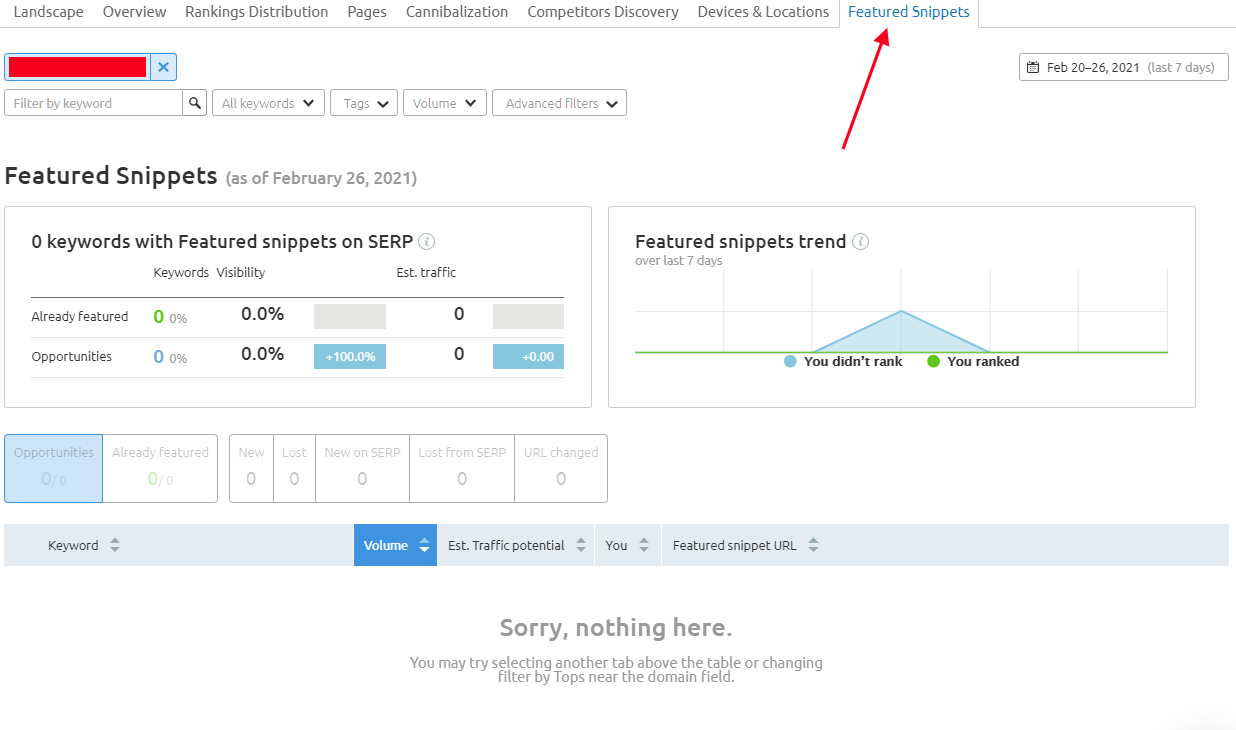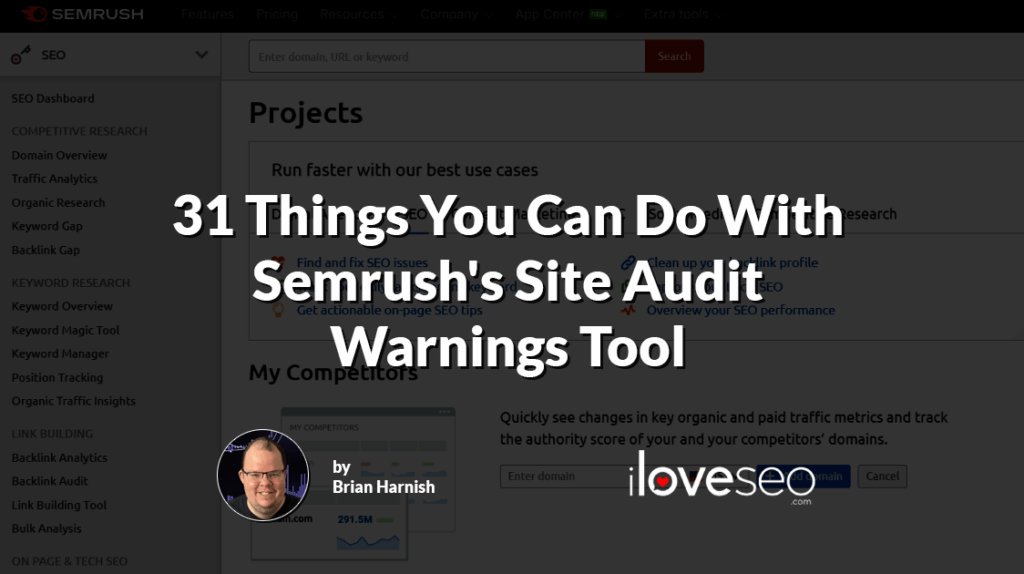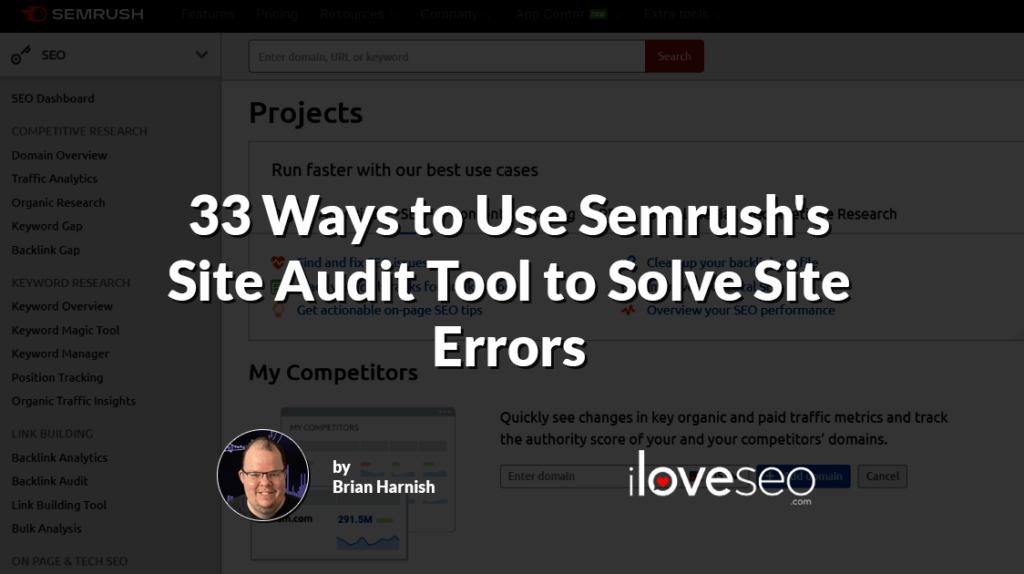Monitor your rankings using Semrush’s comprehensive reporting tools. Every SEO campaign can benefit from comprehensive monitoring of the results of your ongoing SEO efforts.
When it comes to keeping track of your competitive positioning, Semrush provides an all-in-one solution for monitoring your site and making sure that you remain competitive for your all-important keyword phrases.
In addition, the comprehensive monitoring of your competition is worth the price of admission.
Let’s get started with working on setting up our example website for some comprehensive monitoring.
We will begin with competitor research and share insights into some of its benefits for SEO.
Table of Contents
- How Do You Do Competitor Research?
- What Are the Advantages of Competitor Research?
- It Helps to Confirm Your SEO Keyword Strategy
- It Gives You Insight into How Your Competition Is Targeting the Audience
- What Are the Three Types of Competitors?
- What Should Be Included in a Competitor Analysis?
- Key Insights about Your Competitor’s Content
- Key Insights about Your Competitor’s Overall SEO
- Key Insights about Your Competitor’s Social Media Presence
- Landscape
- Visibility
- Estimated Traffic
- Average Position
- Position Tracking Overview Tab
- Rankings Overview Section
- Comprehensive Rank Monitoring and Reporting Is Easier with Semrush
How Do You Do Competitor Research?
Research into your competition for any market can be challenging, and that’s especially true for SEO. This is because of the many factors you must take into consideration. However, there are three that matter to most all SEO practitioners: technical SEO, content and links. Everything else is all but irrelevant.
But what about social media? Doesn’t that play a part in rankings? Somewhat, but indirectly. Because all social media sites are nofollowed, they don’t provide all that much in terms of direct SEO value. Where social media comes in handy, however, is in verifying the authenticity of your content in the eyes of search engines. Articles that have more shares tend to be more legitimate, right?
In this case, the SEO value you get from social media shares is that you may help convince the search engines that your site is more legitimate than others. Plus, you gain those all-important eyeballs on your content.
Competitive research comes in when looking at how things are done from a competitor perspective. To perform a sufficient competitor analysis, you want to answer the following questions:
- How many pieces of content is your competitor publishing daily?
- How are they writing their page titles, meta descriptions and header tags?
- How are they including keywords in their content?
- Is there sufficient linear distribution of keywords?
- What kind of links are they getting?
- How many links are they building to the page?
- How long is their content?
- How do they have their content structured in their overall website architecture?
- What kinds of media do they include in their content?
- Are they optimizing for any rich snippets?
This is where you can gain an edge over your competitors. Becoming better than your competitors doesn’t always mean doing more: It could also mean doing just enough to beat them. But this magical dimension is heavily dependent on your niche and how competitive it is.
What Are the Advantages of Competitor Research?
There are several advantages of competitor research. First, you can really dial in your SEO to attributes that Google is rewarding, rather than blindly going after a strategy that may or may not work. Plus , no one knows exactly what’s behind the algorithm itself or what truly makes it tick— only Google’s engineers do. Unless they otherwise become vocal about the inner workings of Google’s algorithms, there’s really nothing else you can do.
This is why there is such an advantage to doing competitor research in this fashion using Semrush. When you create something within your strategy that’s actually successful, you can review Semrush results and see exactly what kind of an impact it had. In turn, you can then identify other areas where you may be weak in your SEO, and tweak them accordingly.
It Helps to Confirm Your SEO Keyword Strategy
If you want to look for a quick confirmation that your SEO keyword strategy is on the right track, look at what your competition is doing. Finding that keyword strategy sweet spot is something that will help you leverage the information into a strategy that will keep your site competitive.
It also helps to nail down exactly how you want to construct your site and tailor your SEO elements to exceed those competitors.
Plus, you can get more of an idea of how you want to optimize many of your SEO elements in order to exceed what that competitor is currently doing.
It Gives You Insight into How Your Competition Is Targeting the Audience
Are you at a loss as to how you should be going after your target audience? Research your competition. This will give you unparalleled data as to what currently works for your customer base.
If they are successful and where you want to be, it is likely that your competition has already done the research and implemented SEO based on that research.
However, you don’t always want to copy their strategy exactly. The insight does, however, give you solid clues as to where you may want to go next with your overall strategy.
For example, if you find that your competition is ranking for 1,580 words of content, you may want to tailor your content around that word count.
Here’s another example: If you find that your competition is getting a few links from some high-quality websites, then you may want to consider going after those links as well, considering this is something that Google is rewarding. (Please note that Semrush’s content optimization tools give you potential links you can build to your site in addition to the possible on-page optimization strategies you may want to implement.)
What Are the Three Types of Competitors?
In a competitor analysis, it helps to identify the types of competitors you will want to go after as part of your strategy.
Take for example direct competitors. These are those sites which are offering the same products and services as yours. They are involved in the market on a similar level, and will help you identify specific elements of your strategy.
On the other hand, indirect competitors are those who may be in your industry but actually provide different products or services than you.
Identifying these competitors can help you figure out where you may want to go next (vs. where you have been) so you can determine whether or not you would like to “go there” in terms of other sections on your site.
What Should Be Included in a Competitor Analysis?
This one is a loaded question, and an article or two could easily be spent answering this in-depth. But before we get too ahead of ourselves, it’s important to understand that competition is heavily SERP dependent but is not necessarily competitor dependent.
This means you have to look at the individual SERP itself for attributes that competitors have in common across their sites in order to rank. Semrush can help you do all of this and more using their comprehensive monitoring tools for many aspects of digital marketing.
Key Insights about Your Competitor’s Content
Looking at how your competitor optimizes content that’s appearing in the number one SERP position can offer you clues about how to optimize your own. For example, if they target people also ask queries, you may want to target similar ones. And if you find certain topics that the top three sites consistently write about, then you may want to target those topics too.
You can also figure out just how often your competition is publishing their content, along with identifying the topics they cover. You can also gauge, across multiple competitors, where they think their topic focus should be in relation to the audience they are trying to reach.
You will want to examine the following about your competitor’s overall content strategy:
- How much content are they publishing per day (or week, or month)?
- What kind of content are they writing?
- Who is their content geared toward?
- What topics are they actually writing about?
- What other kind of content are they publishing (aside from text)? Videos, images, infographics, memes, or slide decks?
- When are they publishing their content (i.e., at what time of day)?
This information will help you identify key tactics that you will want to implement across your overall content strategy.
Key Insights about Your Competitor’s Overall SEO
SEO is more than keywords and links. It’s also about technical SEO, as well as identifying content opportunities your competitors may be lacking. You shouldn’t just take what your competitors are doing and copy them, though—rather, you must identify new opportunities that they may not have thought of. Here is where you can become a truly unique resource that is a cut above everyone else.
On the other hand, you can also find clues about what your competitors are doing that are getting them to the number one position for that query. While you won’t necessarily figure out exactly what they are doing specifically, you will be able to figure out clues as to what may be benefiting them.
To discover your competitor’s SEO strategy, be sure to look into the following:
- Links: What kinds of high-quality links are they getting?
- Content: What kind of content are they writing?
- Technical SEO: What is the state of their website now?
- Keywords: What types of keywords are they targeting?
- On-page optimization: How are they currently optimizing their content?
Questions like these will help you identify key things you will need to do to your own site in order to propel yourself to the next level in the SERPs.
Key Insights about Your Competitor’s Social Media Presence
Your competitor’s social media presence is also a great place to unearth data about their audience. Chances are, their audience and yours tend to criss-cross each other in the same industry, so their social media presence may offer clues about how they are achieving social media domination.
For example, they may be posting some content geared towards politics in order to entice buyers who have a political spin. Or, they may be posting humor on a more regular basis. Perhaps they are posting more thought-provoking TED-talk type content. Or, maybe they are posting funny memes all the time.
This is something you will want to know as you embark on your own social media strategy. Also investigate:
- the day and time that their customers (and your customers) engage with content;
- the kind of content your customers (and their customers) consume;
- content that strikes a chord with the audience such as quotes, videos, thoughtful anecdotes and the like;
- any frameworks that your competition may be using to create their social posting calendars; and
- how much and how often your competition posts.
By identifying these key insights among your top competitors, you can get in front of their audience as well and really make your social media strategy take off.
Landscape
The landscape section of Semrush’s position tracking tool allows you to monitor and assess where your site currently is among the existing landscape of your competitors.
It’s useful for identifying your site’s visibility, its estimated traffic, average position, and many other metrics.
From here, you can make tweaks to your overall optimization strategy to improve your site’s positions.
It is important to note at the outset that Semrush uses estimates to determine a site’s overall visibility within the top 100 Google results. It doesn’t, however, take into account positions below 100.
Other tools like Ahrefs, may take this into account.
Visibility
This aspect of the report is actually based on CTR (click-through rate). You must input your own keywords for this to work, so it’s not all-encompassing when it comes to the results.
In other words, it works by tracking your existing tracked keywords. It’s also relative and is based on how many keywords you are ranking for.
For example, if you keep rankings for 100% of all of your keywords, that would count for 100 percent visibility.
This visibility does not take into account how you may be performing compared to many thousands of other keywords in the index.
Estimated Traffic
From what Semrush says, this estimation is based on average click-throughs over all positions in Google’s results multiplied by the volume and divided by 30 (the number of days in a month).
This also shows the probability that a user will click on a particular domain’s search result, based on its position in the SERP.
If you find that you have a lower traffic estimation, this report gives you clues as to what part of your strategy you will want to change next.
Average Position
This part of the report gives you the average ranking of all keywords you have entered into your tracking campaign. Here, a rank of 100 means that you are not ranking for that keyword.
If you click on the average position report link within Semrush’s report, you will get the following information:
This report shows a graph of your average position performance over the past 30 days.
If you want to obtain more detailed insights from the report, you can add the domains of your competitors as shown:
Just add your competitor’s domain(s) from the list that pops down when you click on Add domain, and Semrush will generate a component of the report that gives you more insight into these competitors.
The following section (shown below) provides general information regarding which keywords your site ranks for, whether or not it ranks in the top three, the top ten, the top 20 or even the top 100.
All of these are important to understanding where your site ranks overall.
The rankings distribution section provides more information about specific distributions of rankings. These include how many keywords are ranking within the top three, the top four–ten, the top 11–-20, and finally the top 21–100.
The top 21–100 rankings do not really matter as much as the first three, and the top page two rankings don’t matter as much as those on page one. But, it is useful when it comes to gauging your own rankings performance.
This section is relatively simple—it shows the top performing keywords for your domain.
Both of these sections include, when data is available, the positive and negative trends of rankings over the time period that you have selected.
In this section, you can see your top competitors and how their online visibility continues to improve (or not).
By rolling over the Top Competitors circles in the left hand column, you can see their keyword ranking distribution, as well as other useful information.
Here, you will be able to identify the types of SERP features that your site is ranking for. SERP features are things like rich snippets, reviews, featured snippets and other types of snippets governed by Schema markup.
The Pages section shows the landing pages that are ranking, how many keywords they are ranking for, their average position and the estimated traffic the landing page is receiving.
Semrush landing page traffic estimates are different than those from Google Analytics and Google Search Console. Because they don’t have access to the same data, it’s important to take Semrush’s data with a grain of salt, and use its data points more as general indicators than as hard traffic numbers.
The cannibalization health section checks for keyword cannibalization. This occurs when you have more than one page optimized for the same keyword phrase and they are vying for the same attention in Google’s SERPs.
In a perfect world, everyone would use correct SEO best practices. However, we are not in a perfect world, and this happens more often than not.
Identifying keyword cannibalization issues can help prevent your site’s pages from competing for traffic that they both may deserve.
Position Tracking Overview Tab
In the position tracking overview tab, we find yes, even more ranking position tracking.
Here, to get the most out of your data, you will want to continue adding in your competitors. You can add up to four more competitors for a total of five entries.
There are also additional filters that you can select, in order to filter just the data that you want.
Filtering by top positions and changes, you can show exactly what keyword distribution you want to see. Whether it includes keywords in the top three, top ten or top 100, you may want to create a report from this data.
Scrolling down to the next section, we can see all the data thus far that shows an overview of all competitor domains (including your own). If you roll over the lines, you will get a pop-up showing the overall online visibility percentage for all of your competitors.
This gives you insight into how your site is performing based on comparisons with your top chosen competitors.
Rankings Overview Section
This section of the position tracking overview tab allows you to see your rankings at a glance for all of your keywords. It also allows you to examine all of the types of snippets your keywords actually rank for.
They will show up based on the types of SERP features that exist in that SERPs. For example, if a keyword only has site links or people also ask answer boxes, they will show up in the SERP features column.
If they don’t exist, they will simply not show up in this list.
If you click on the keyword section you’ll see rankings for that specific keyword, in addition to those of all the competitors you have selected.
If you scroll to the right using the scroll bar up top, you will be able to see your competitors as well.
This will give you tremendous opportunity for insight into how you, along with your competitors, are currently performing in the SERPs.
But what do the icons mean?
This one means that you have a local pack on that SERP (not that you’re ranking for it, just that the SERP feature appears on that SERP).
The graduation cap means that you have a knowledge panel showing up on the SERP.
The star means you have review snippets that are present on the SERP.
This little news icon over here means that you will see top stories on the SERP.
This little questions icon shows that you will have People Also Ask answer boxes on the SERP.
This icon that looks like a graphic means that you have images showing up on the SERP.
The little ads icon up above means that you have AdWords ads showing up at the top of that SERP.
Also, this icon shows that there are AdWords ads showing up at the bottom of that SERP.
The icon that looks like a link is exactly that—this indicates that sitelinks features are showing up on the SERP.
For you and your tracking efforts, this means that you can filter each keyword by that specific SERP snippet and figure out exactly where your site is performing for that SERP snippet.
The estimated traffic tab shows you estimated traffic for the keyword, along with any SERP features you want to filter.
The visibility tab also shows you how the visibility of your site is being influenced by your specific keywords.
If you click on table settings to the right, you will be able to customize this to your needs. Whether you want to view a certain selection of columns or change the row height, you could sort by any data point listed here.
This will allow you to customize your reports based only on the data points that you need.
The rankings distribution tab shows you, well, the distribution of your rankings. First, the overall rankings distribution section shows how your site is doing against your competition.
The accompanying columns are dedicated to:
- estimated traffic;
- traffic coming from keywords ranking in the top three;
- traffic coming from keywords ranking in the top ten;
- traffic coming from keywords ranking in the top 20; and
- traffic coming from keywords ranking in the top 100.
All of the report’s sections below this are dedicated to keywords ranking in the top three, top ten, top 20 and top 100, respectively.
The next tab, or the pages tab, is a listing of your landing pages along with their ranking keywords, estimated traffic, average position and total traffic volume.
The competitors discovery tab is a fun twist on competitor analysis.
This research will give you all of your organic competitors within the search results. You will be able to examine their visibility performance, estimated traffic performance, number of rankings keywords and overall average page position.
The last tab is the featured snippets tab.
While it’s not currently populated for the specific site used in this tutorial, this will allow you to see things like trends for featured snippets, which keywords have featured snippets on the SERP, available opportunities, and much more. Keywords and their featured snippets attributes will show up below as well when they begin ranking.
Comprehensive Rank Monitoring and Reporting Is Easier with Semrush
Whenever you embark on any new SEO campaign, comprehensive monitoring of your site’s performance is key to impressing your client. From traffic to rankings to keywords, many elements of SEO intersect to provide a data-plus-wisdom reporting philosophy.
Data is all well and good, but the client is not going to understand just data alone (unless they are also an SEO pro). That’s where wisdom comes in: It helps to distill the data into manageable chunks so the client understands what you’re talking about, why we’re doing it and how it results in an improvement to their bottom line.
If you don’t create comprehensive monitoring reports based on real-world data, you could end up with inaccurate interpretations. This wisdom plus data philosophy is critical to keeping your client on your side and singing your praises. As you put together comprehensive reports that help your client understand each piece of the puzzle, you will find that it really does beat creating reports that only take into account half of the picture.
How do you plan on using Semrush comprehensive monitoring and reporting to delight your clients?
Image credits:
Screenshots by author / February 2021




